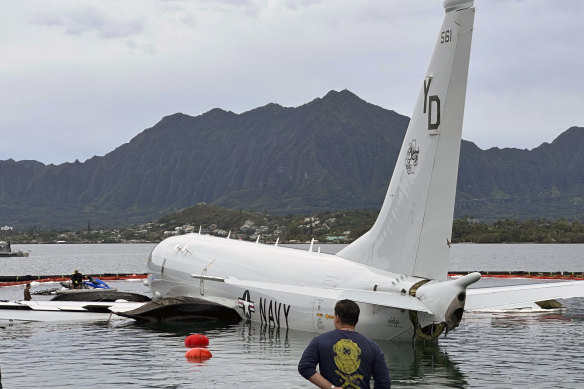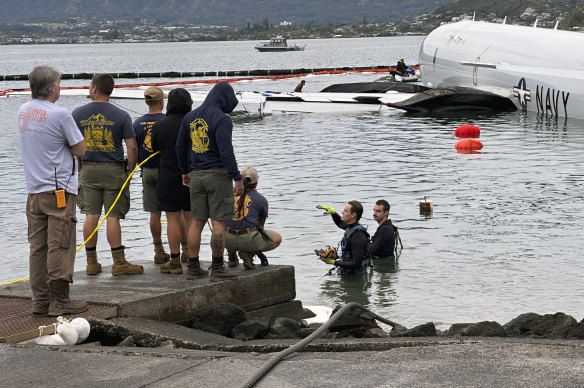Save articles for later
Add articles to your saved list and come back to them any time.
Honolulu: The US Navy estimates it will cost $2.25 million to salvage a jet plane that crashed on a coral reef in Hawaii nearly two weeks ago.
Navy spokesman Mohammad Issa said the $US1.5 million salvage efforts are focused on protecting the environment and safely recovering the aircraft in a way that retains its combat capability. He said $US200,000 ($300,000) has already been spent on the operation.
The US Navy aircraft is lifted to the surface by inflatable bags.Credit: AP
The navy plans to use inflatable cylinders to lift and roll the jet plane off the reef where it crashed on November 20.
The P-8A, the military’s version of a Boeing 737 jet, slammed into an environmentally sensitive bay about 16 kilometres from Honolulu when it overshot the runway at Marine Corps Base Hawaii. None of the nine people on board were injured. The cause of the crash is under investigation.
Rear Admiral Kevin Lenox, the commander of Carrier Strike Group 3 who is leading the salvage effort, said he is confident the operation can be carried out without further damaging the reef.
The navy released underwater video on Wednesday showing the aircraft’s landing gear wheels resting on parts of crushed coral and much of the rest of the plane floating above the reef in Kaneohe Bay.
The aircraft is expected to fly again, but the salvage effort will cost more than $2 million.Credit: AP
A navy team has removed nearly all of the estimated 7500 litres of fuel from the aircraft.
Hawaii state officials are due to examine the reef for damage once the plane is removed.
Kaneohe Bay is home to coral reefs and a range of marine life, from sharks to octopus and fish. The area hosts an ancient Hawaiian fishpond being restored by community groups.
Contractors performed a similar feat when they removed a barge weighing 907 tons from sensitive seagrass habitat in North Carolina after Hurricane Florence in 2015.
The plane weighs about 54 tons.
The navy considered floating the jet within range of a crane on the runway and then lifting the plane onto land. Lenox said the inflatable cylinder option was the safer method, was expected to have little to no effect on the coral and would not impact the aircraft.
The jet is in good condition and the navy hopes to get it flying again, Lenox said.
The navy uses the P-8A to search for submarines and conduct surveillance and reconnaissance.
AP
Get a note directly from our foreign correspondents on what’s making headlines around the world. Sign up for our weekly What in the World newsletter.
Most Viewed in World
From our partners
Source: Read Full Article




